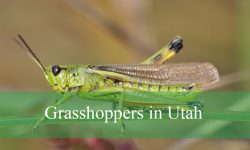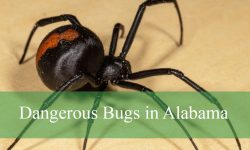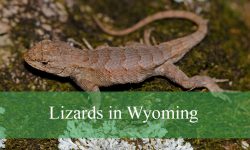Hawaii’s tropical environment provides the perfect conditions for many species of cockroaches to thrive. The warm temperatures and high humidity allow these insects to live and breed year-round, both indoors and outdoors. From city apartments to lush coastal gardens, roaches have adapted to nearly every habitat across the islands.
These insects are masters of survival, feeding on almost any organic material they can find. In urban areas, they hide in sewers, basements, and kitchens, while in rural and garden settings, they shelter under mulch, leaves, and stones. Each species has unique traits, sizes, and behaviors that make identification important for effective pest control.
This complete guide highlights ten common roach species in Hawaii, covering their physical features, preferred environments, and habits. It also includes practical tips to reduce infestations and frequently asked questions about managing roaches in the islands’ tropical climate.
Common Types of Roaches Found in Hawaii
American Cockroach (Periplaneta americana)
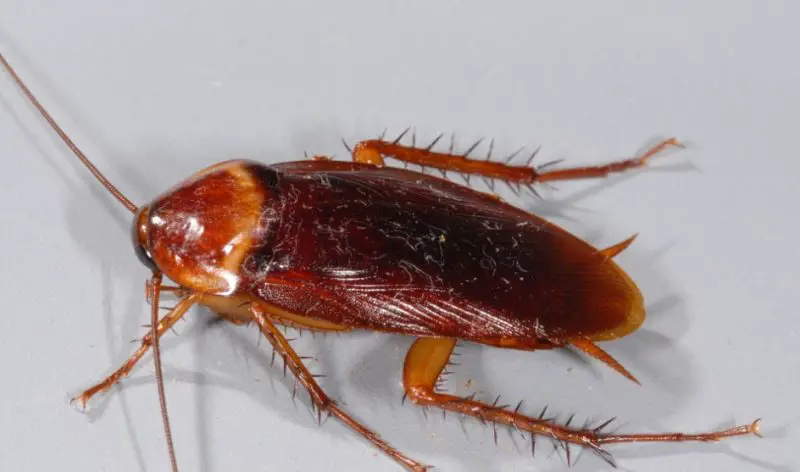
The American cockroach is the largest and one of the most recognizable roaches in Hawaii, often measuring between 1.5 to 2 inches in length. It has a reddish-brown body with a distinctive yellowish figure-eight marking on the back of its head. Its wings extend slightly beyond the tip of the abdomen, and both males and females are capable of flight, though males are slightly more agile in the air. When startled, these roaches can glide short distances, which often causes alarm in households.
In terms of behavior, American cockroaches are mostly nocturnal and highly active during warm, humid nights. They are scavengers that feed on decaying organic matter, food crumbs, and even paper products. In Hawaii, they are often seen flying toward porch or street lights, particularly during the humid evenings following rain. This attraction to light and moisture makes them one of the most visible species in urban areas.
Their preferred habitats are dark, warm, and moist environments such as sewers, basements, crawl spaces, and bathrooms. In commercial buildings, they can be found around drains, grease traps, and garbage disposal areas. Outdoors, they often inhabit decaying logs, mulch, and garden debris, making them well adapted to Hawaii’s tropical climate. They are also known to enter homes through small cracks, pipes, and vents in search of food and water.
In Hawaii, controlling American cockroach infestations can be challenging because of their mobility and ability to survive in various environments. Regular cleaning, sealing entry points, and reducing moisture are crucial steps. They are often resistant to certain pesticides, so professional pest management may be required in large infestations, especially in older homes near vegetation or sewage systems.
German Cockroach (Blattella germanica)
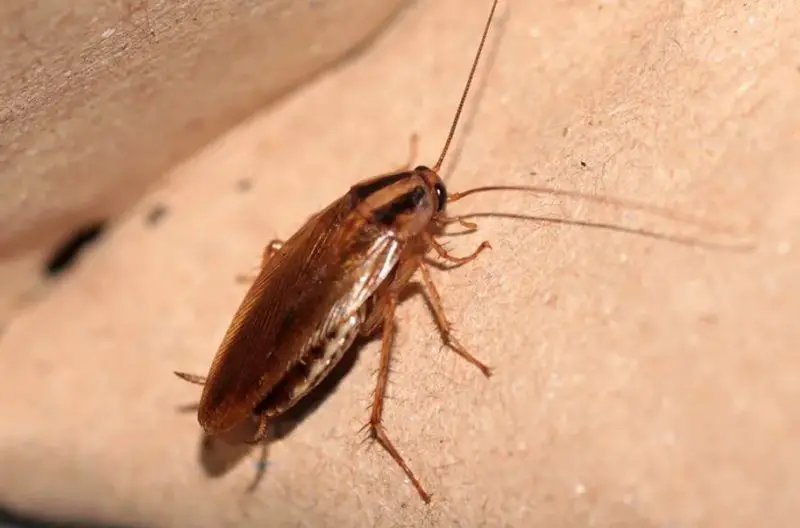
The German cockroach is one of the most persistent indoor pests in Hawaii, commonly infesting apartments, restaurants, and hotels. Adults measure about ½ inch in length and are light brown to tan with two distinct dark stripes running down their pronotum. Their small size and flattened bodies allow them to easily hide in tiny cracks, behind appliances, and under kitchen sinks. Despite their fragile appearance, they are highly adaptable and thrive in urban settings.
Unlike many other roaches, the German cockroach reproduces rapidly. A single female can produce hundreds of offspring in a short period, as she carries her egg case until just before the eggs hatch. In Hawaii’s warm climate, their life cycle accelerates, meaning infestations can develop quickly if not controlled early. Because they live close to food sources, they are often seen scurrying near crumbs, grease residues, or food spills.
Their primary habitat includes kitchens, bathrooms, and other areas where heat and humidity are consistent. They often hide behind refrigerators, stoves, microwaves, and inside cabinets. In commercial settings, such as restaurants and bakeries, they can infest food storage areas and appliances. They are nocturnal, emerging at night to feed on crumbs, grease, and even soap or toothpaste.
German cockroaches are not only a nuisance but also a health concern in Hawaii. They can contaminate food and surfaces with bacteria, triggering allergies and asthma in sensitive individuals. Preventive measures include keeping areas clean and dry, sealing food in airtight containers, and using bait traps strategically. Because they reproduce so rapidly, even a small infestation can quickly become overwhelming without persistent treatment.
Oriental Cockroach (Blatta orientalis)
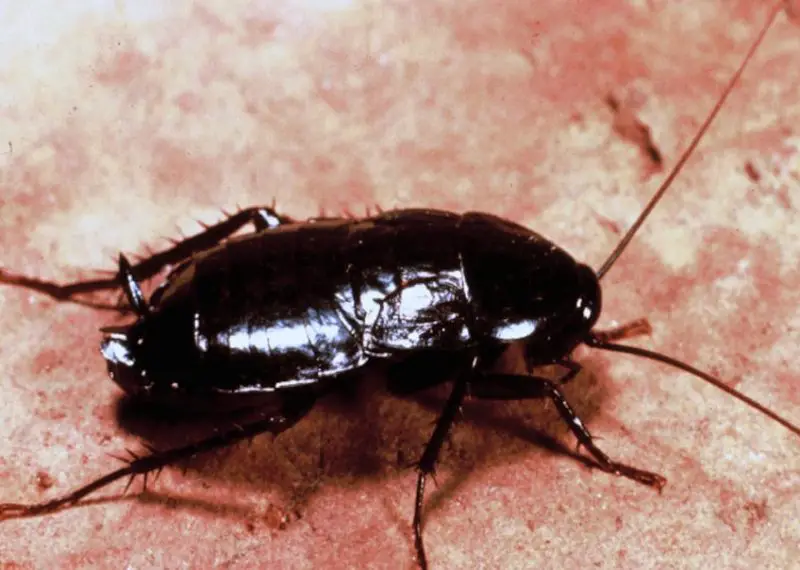
The Oriental cockroach, also called the “black beetle roach,” is a glossy dark brown to nearly black species that prefers cool, damp environments. Adults range from 1 to 1.25 inches long, with females appearing broader and darker than males. Males have shorter wings that cover about two-thirds of their bodies, while females have tiny wing pads and cannot fly. Their shiny exoskeleton gives them a distinctive, almost oily appearance.
This species is less active and slower-moving compared to others, but it is highly resilient. It is most often found outdoors in moist environments such as under mulch, stones, or piles of decaying leaves. In Hawaii, they are frequently seen around gardens, storm drains, and garbage bins. They are drawn to organic material and can survive on decaying plant matter or waste, making them well-suited to tropical outdoor conditions.
Indoors, Oriental cockroaches are usually found in basements, bathrooms, and crawl spaces where humidity levels are high. They enter homes through cracks in foundations or through drains and sewer pipes. Unlike flying roaches such as the American or smokybrown species, the Oriental cockroach relies on crawling to find shelter and food. They are also known to emit a strong, musty odor when disturbed or present in large numbers.
Because they thrive in moist environments, reducing dampness around the home is key to controlling their populations in Hawaii. Fixing leaks, improving ventilation, and sealing foundation gaps can prevent infestations. While Oriental cockroaches do not spread as quickly as other species, they are difficult to eliminate once established, particularly in shaded or overgrown outdoor areas.
Surinam Cockroach (Pycnoscelus surinamensis)
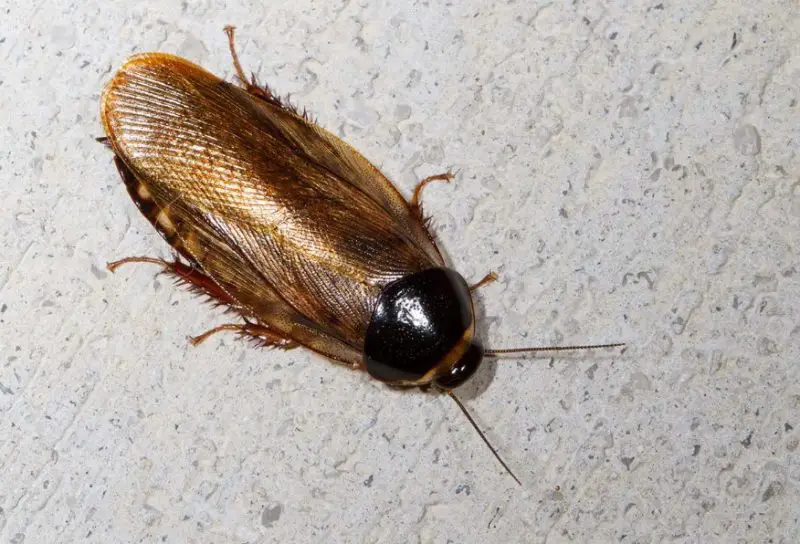
The Surinam cockroach is a tropical species perfectly suited to Hawaii’s climate. Adults grow to about 1 inch long and have a shiny, dark brown body with lighter edges on their wings. Their wings completely cover the abdomen, but despite their appearance, they rarely fly. These roaches are strong burrowers and are primarily found outdoors in soil, gardens, and landscaped areas, where they spend most of their lives underground.
One fascinating feature of the Surinam cockroach population in Hawaii is that it consists entirely of females. They reproduce through parthenogenesis, meaning each female can produce offspring without mating. This allows colonies to expand rapidly, particularly in moist soil environments. They feed mainly on decaying plant material and roots, but in heavy infestations, they may damage seedlings and potted plants.
These roaches are most active during warm, humid nights. They burrow into mulch, compost piles, and garden beds during the day to avoid sunlight. Because they thrive in soil, they can easily spread through potted plants, nursery soil, and landscaping materials. In Hawaii, they are common in tropical gardens and greenhouses, where they contribute to organic decomposition but can become pests when populations grow large.
The Surinam cockroach rarely invades homes, but when it does, it’s usually due to excessive moisture or soil-rich areas near walls or foundations. Preventive care includes keeping garden mulch thin, reducing standing water, and inspecting potted plants before bringing them indoors. While generally harmless to humans, their presence can be unsettling and may signal excess moisture or organic buildup around a property.
Brown-banded Cockroach (Supella longipalpa)
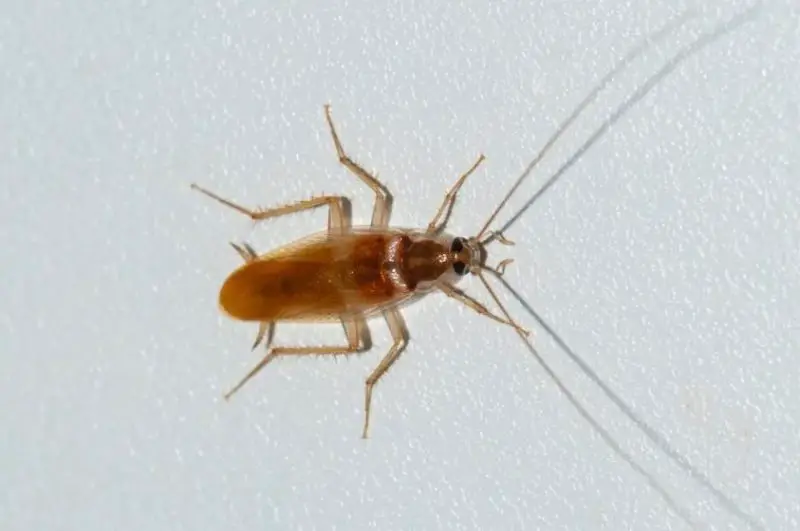
The Brown-banded cockroach is one of the smaller species in Hawaii, measuring about ½ inch long. It can be identified by two light-colored bands that stretch across its wings and abdomen, which remain visible even in adults. Unlike many other cockroach species, the Brown-banded roach prefers drier environments and warmer temperatures, making it more common in bedrooms, living rooms, and offices rather than kitchens or bathrooms.
This species has a unique behavior pattern — it often hides in elevated or less humid areas. Brown-banded cockroaches can be found behind picture frames, inside light fixtures, behind electrical appliances, and even inside electronics. Because they tend to avoid water, they are less dependent on moisture and can survive longer periods without it. They are also more likely to be found on ceilings or higher walls rather than near the floor.
In Hawaii, their infestations are often subtle and difficult to detect at first because they disperse throughout the house rather than clustering near food or water sources. They feed on a variety of organic materials, including crumbs, glue, and even fabric. They are nocturnal, emerging at night to feed and reproduce, and females attach their egg cases to hidden surfaces, allowing populations to grow quietly over time.
To prevent and control Brown-banded cockroaches in Hawaii, consistent cleaning and sealing of small openings are essential. Because they often hide in electronics and furniture, vacuuming and inspecting household items is important. Their adaptability to dry conditions makes them harder to eliminate with standard roach baits designed for moisture-seeking species, so integrated pest control methods are recommended.
Smokybrown Cockroach (Periplaneta fuliginosa)
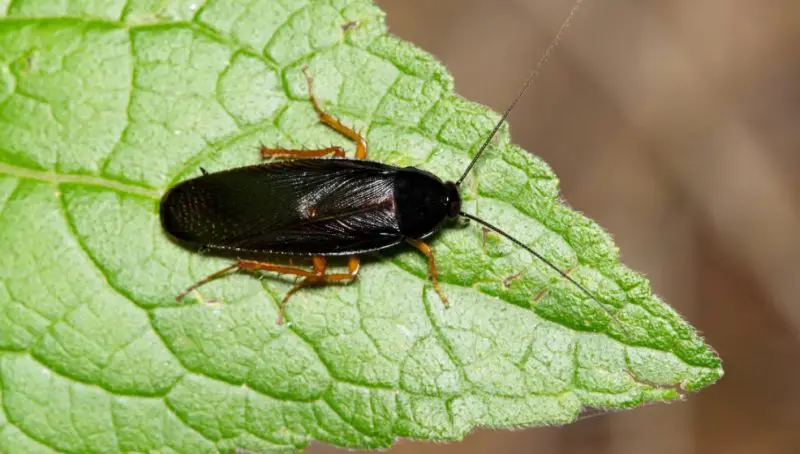
The Smokybrown cockroach is a large, sleek species closely related to the American cockroach but slightly smaller, typically reaching about 1.25 inches in length. It has a uniform mahogany or dark chocolate-brown color that distinguishes it from the reddish tones of the American species. Its body is glossy and smooth, with fully developed wings that extend beyond the abdomen. Both males and females are excellent fliers, often taking to the air at dusk or during humid evenings in Hawaii.
This roach species thrives in warm, moist environments, making the Hawaiian climate ideal for its survival. Smokybrown cockroaches are commonly found in outdoor habitats such as tree holes, mulch beds, palm fronds, and rain gutters. They are also frequent inhabitants of compost piles and roof eaves, where organic debris collects. In the evenings, they become active and may fly toward lights or open windows, occasionally entering homes in search of water and food.
Inside homes, Smokybrown cockroaches typically appear near sources of moisture — bathrooms, kitchens, or under sinks. They are drawn to fermented foods, plant material, and even garbage. Because they dehydrate easily, they require constant access to moisture, which limits their ability to survive long indoors unless conditions are damp. Their presence indoors is often seasonal, peaking during Hawaii’s warmest, most humid months.
Controlling Smokybrown cockroaches involves outdoor management first. Sealing entry points, clearing leaf litter, and trimming trees that touch buildings can greatly reduce infestations. Reducing standing water around the property is crucial since this species cannot survive without humidity. Outdoor bait stations and residual sprays around foundations can help minimize populations and prevent them from entering homes at night.
Australian Cockroach (Periplaneta australasiae)
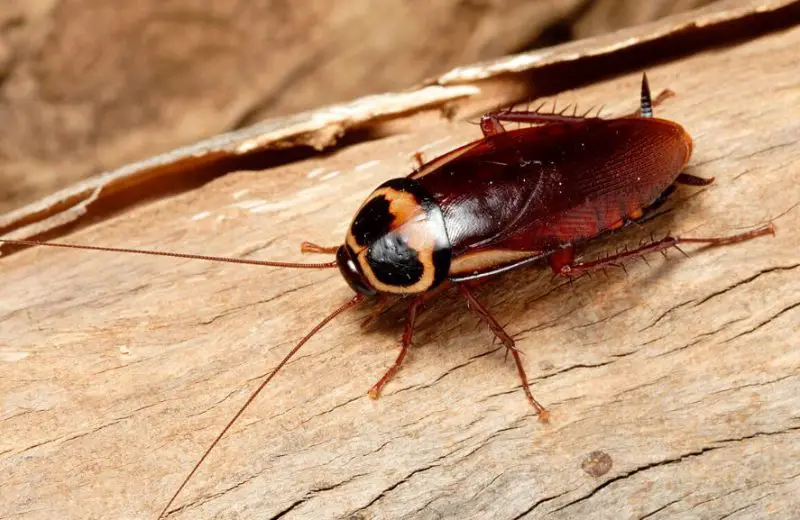
The Australian cockroach is a tropical species well adapted to Hawaii’s lush, humid climate. Adults measure between 1.25 and 1.5 inches in length and are reddish-brown with distinctive yellow markings along the outer edges of their wings and a bright yellow band outlining the thorax. These markings make them easily distinguishable from the American cockroach. They possess strong wings and can fly short distances, particularly during humid nights.
This species prefers outdoor habitats and is often found in gardens, greenhouses, and compost piles. In Hawaii, Australian cockroaches thrive among tropical vegetation, hiding under bark, leaves, and decaying wood. They feed primarily on plant matter, fungi, and decomposing organic material. However, during dry or extremely wet conditions, they may venture indoors through open doors, vents, or gaps near windows.
Indoors, they are occasionally found in kitchens, basements, or bathrooms but typically do not form large infestations. Unlike the German cockroach, they are more dependent on outdoor moisture and warmth. They can survive briefly indoors if they have access to both food and water sources. In urban areas, they are sometimes found in potted plants, utility areas, and garden sheds.
Preventing infestations involves maintaining outdoor cleanliness and controlling vegetation near buildings. Removing piles of wood, mulch, and fallen leaves helps reduce their hiding spots. In Hawaii’s tropical neighborhoods, homeowners often use perimeter baiting and sealing outdoor openings to keep these roaches from entering. While generally harmless, their large size and sudden flight can alarm residents, especially when attracted to lights at night.
Field Cockroach (Blattella vaga)
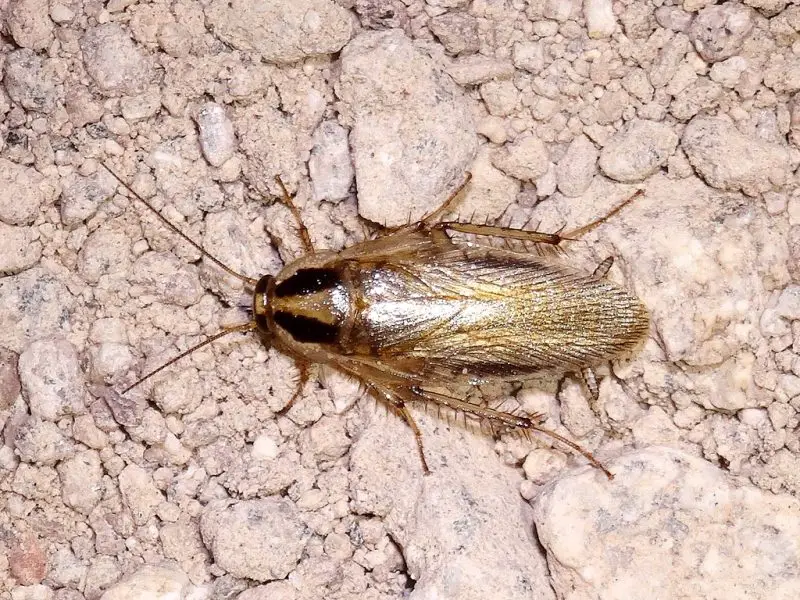
The Field cockroach is a small, light-colored species, usually measuring about ½ inch long. Its appearance is similar to that of the German cockroach but with a slightly greenish or olive tint. The Field cockroach has two dark stripes on its pronotum, but its body is more translucent and less glossy. Unlike other household pests, this species prefers the outdoors and does not thrive indoors for extended periods.
In Hawaii, the Field cockroach is commonly seen around lawns, gardens, and flowerbeds. It feeds primarily on decaying organic matter and plant debris, occasionally nibbling on tender plant tissue. Because it’s attracted to light, it often gathers near outdoor lamps and patios at night. However, it rarely becomes a serious pest indoors, as air-conditioned, dry environments do not suit its needs.
These roaches typically inhabit areas with mild moisture such as under stones, mulch, and leaf litter. During the day, they remain hidden and emerge at dusk to forage. They are capable of flying short distances, though they primarily rely on running to escape threats. In the Hawaiian ecosystem, they contribute to organic decomposition, helping recycle plant material naturally.
To prevent them from entering homes, homeowners can keep windows and doors closed at night and reduce exterior lighting that attracts them. Maintaining garden hygiene and clearing debris also helps lower their numbers. Since Field cockroaches are not true indoor pests, chemical control is rarely necessary unless they appear in large numbers around residential areas after heavy rains.
Cuban Cockroach (Panchlora nivea)
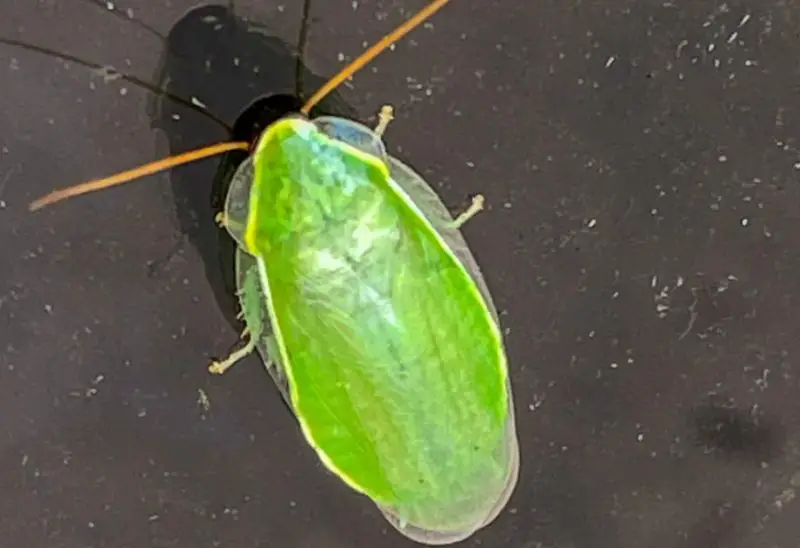
The Cuban cockroach, also known as the green banana roach, is one of the most visually striking cockroach species found in Hawaii. Adults are bright green, with fully developed wings that shimmer under light. Measuring about ¾ to 1 inch long, they have slender bodies and are excellent fliers. Nymphs, however, are dark brown and wingless, looking completely different from adults until they mature.
This species prefers outdoor environments filled with vegetation. It is most commonly found in tropical gardens, banana trees, palm fronds, and compost heaps. In Hawaii, Cuban cockroaches play an ecological role by feeding on decaying plant matter, contributing to the breakdown of organic material. They are not attracted to food crumbs or trash like other roaches, which makes them relatively harmless as household pests.
At night, these roaches are drawn to bright lights and may accidentally fly indoors through open windows or doors. They are active fliers and often appear on patios or porches during the evening. Once indoors, they rarely stay long and usually die quickly if they cannot return to their natural habitat. Their attraction to light and quick, fluttering flight sometimes leads to mistaken identity as green beetles or moths.
Controlling Cuban cockroaches in Hawaii typically involves reducing outdoor lighting and sealing gaps around windows. Since they thrive outdoors in lush vegetation, trimming plants and maintaining garden cleanliness helps keep them away from living areas. These cockroaches are more of a curiosity than a pest, admired for their unique color and graceful movement.
Turkestan Cockroach (Shelfordella lateralis)
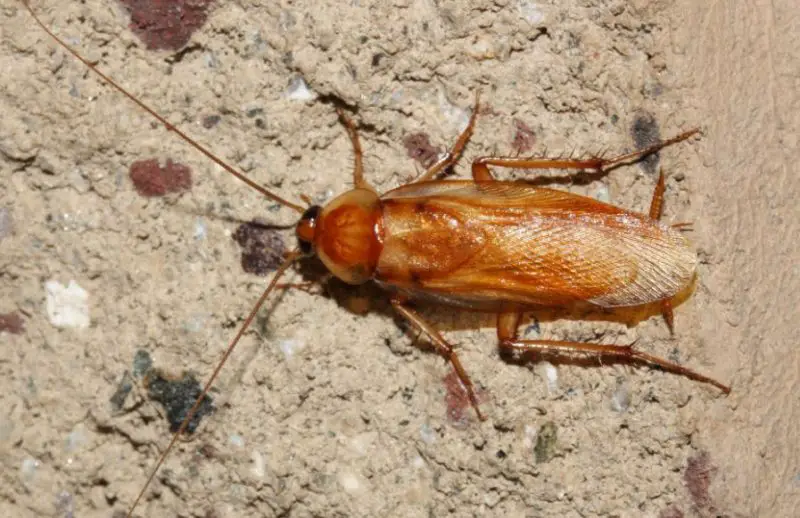
The Turkestan cockroach is an emerging species in Hawaii, introduced through imported goods and construction materials. It exhibits distinct sexual dimorphism — males are reddish-brown with long, narrow wings that extend beyond their bodies, while females are darker, more robust, and have shorter wings with rounded bodies. Adults typically grow between ¾ to 1 inch long.
This species prefers dry, warm environments and is commonly found outdoors in cracks, crevices, leaf litter, and around foundations. In Hawaii, they often inhabit garden walls, drainage areas, and piles of debris. They are fast runners and generally avoid light, though males can sometimes be seen flying at dusk. Their activity peaks during warm evenings, making them more noticeable during summer months.
Turkestan cockroaches feed on decaying organic matter, garbage, and leftover food scraps. They are opportunistic scavengers and can survive long periods without food but not without water. Although they primarily live outdoors, they may enter homes through open doors, vents, or drains when seeking moisture or shelter. They often compete with Oriental cockroaches for similar habitats but tend to reproduce more quickly.
Managing Turkestan cockroach populations in Hawaii involves keeping outdoor areas clean and dry, reducing clutter, and sealing foundation gaps. Since they are more common around human structures, perimeter treatments and outdoor baits can effectively reduce their numbers. Although not as common as other species yet, their adaptability suggests that Turkestan roaches may become more widespread in Hawaii’s dry urban areas in the coming years.
Tips for Dealing with Roaches in Hawaii
Keep Homes Dry and Clean
Roaches thrive in Hawaii’s warm, humid environment, so minimizing moisture indoors is one of the most effective control strategies. Fix leaky pipes, dry out damp areas under sinks, and use dehumidifiers when possible. Regularly cleaning kitchen counters, removing grease build-up, and vacuuming crumbs can drastically reduce available food sources. Roaches are opportunistic feeders, so even small traces of food or moisture can sustain a colony.
Seal Entry Points and Reduce Outdoor Hiding Spots
Because many Hawaiian roach species live outdoors, they often enter homes through small cracks, vents, or drains. Seal any gaps around doors, windows, and pipes with weather stripping or caulking. Outdoors, trim vegetation that touches walls, clear leaf litter, and store firewood away from the house. Reducing clutter and maintaining a well-kept yard makes it harder for roaches to establish colonies near your home.
Use Bait Stations and Traps Strategically
Baits and gel traps work well for controlling roach populations, especially German and American cockroaches. Place bait stations behind appliances, in cabinets, and along walls where activity is noticed. Outdoor baiting can help control larger roach species such as Smokybrown or Australian cockroaches. Avoid spraying insecticides directly near baits, as sprays can repel roaches and reduce bait effectiveness.
Manage Lighting and Outdoor Moisture
Roaches like the Smokybrown, Cuban, and American species are attracted to lights at night. Use yellow “bug lights” for outdoor fixtures and keep patio or porch lights off when not needed. Managing water sources — including pet bowls, garden irrigation, and birdbaths — helps reduce the humidity that attracts roaches. In Hawaii, keeping outdoor areas dry and dark is a natural deterrent for many flying cockroach species.
FAQs About Roaches in Hawaii
What causes roaches to be so common in Hawaii?
Hawaii’s tropical climate — warm, humid, and consistent year-round — creates ideal conditions for cockroaches to breed and survive. The abundance of vegetation, organic debris, and moisture provides them with constant shelter and food sources. Even urban areas, with sewer systems and damp basements, mimic their preferred natural habitats.
Which cockroach species is the most common indoors in Hawaii?
The German cockroach (Blattella germanica) is the most common indoor species in Hawaii. It thrives in kitchens, bathrooms, and restaurants, where food and humidity are always available. Because of its rapid breeding cycle, a small infestation can grow exponentially within weeks if left untreated.
Do flying cockroaches in Hawaii really fly toward people?
Yes, certain species like the American and Smokybrown cockroaches are strong fliers and often fly toward lights or movement, which can appear as though they are flying directly at people. They are not attacking — they are simply disoriented by the light sources or air currents in enclosed spaces.
Are cockroaches in Hawaii dangerous?
While roaches in Hawaii don’t bite or sting, they can spread bacteria and allergens. Their droppings, shed skins, and saliva can trigger asthma and allergies, particularly in children. They may also contaminate food and surfaces, especially in kitchens and restaurants, making sanitation an important part of control.
How can I tell the difference between American and Australian cockroaches?
Both species are large and reddish-brown, but the Australian cockroach (Periplaneta australasiae) has distinctive yellow margins along the wings and thorax, while the American cockroach (Periplaneta americana) has a yellowish figure-8 marking behind the head. The Australian species also tends to live outdoors more often, particularly in gardens and compost piles.
Can roaches survive outside all year in Hawaii?
Absolutely. Because Hawaii never experiences freezing temperatures, roaches can live outdoors throughout the year. Many species — such as the Smokybrown, Surinam, and Cuban cockroaches — are well adapted to the tropical landscape and thrive in mulch, palm fronds, and decaying vegetation. Indoor infestations usually occur when these outdoor species seek food or water inside.
What’s the best way to prevent roaches from coming indoors?
Prevention in Hawaii centers on cleanliness and exclusion. Keep food sealed, garbage covered, and drains clean. Seal cracks, vents, and wall openings where pipes or cables enter. Reduce exterior lighting, trim plants away from walls, and regularly inspect potted plants or garden soil for Surinam cockroaches. Routine maintenance is key in a tropical environment where roaches are abundant.
Should I call pest control for roaches in Hawaii?
If you’re dealing with repeated infestations or fast-breeding species like the German cockroach, professional pest control is highly recommended. Experts can identify the species, locate nesting areas, and apply targeted treatments. Because Hawaii’s climate supports multiple species simultaneously, a long-term integrated pest management (IPM) plan is often necessary for lasting results.



